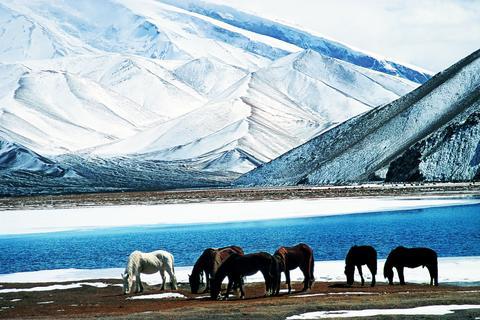In an outdoor space at the base of the Taipei 101 building, the National Geographic Channel has set up a small, but interesting photo exhibition derived from its upcoming three-part series Marco Polo: The China Mystery Revealed.
The 57 photos on exhibit were taken by long-time National Geographic photographer Michael Yamashita and are part of a voluminous compendium of shots that inspired the channel to retrace Marco Polo's steps through Central Asia, China and then back to Italy via Southeast Asia for a TV

PHOTO COURTESY OF NATIONAL GEOGRAPHIC
documentary.
As is to be expected from the magazine's documentary style, Yamashita's photos portray the parts of the world that Marco Polo traveled through in a manner that consciously tries to blur the distinction of time to emphasize the "exotic" nature of the subjects and in some cases to imagine what scenes must have looked like to Marco back in the 13th century. The overall effect also hints at how little modernity has encroached on these places, though in the case of China this required some fancy staging of
photographs.
"In Dunhuang (China) the camel caravan I wanted to shoot was actually for tourists. The animals had numbers on their sides, which didn't look good at all. So I took the shot with the camels back-lit and there you go, I had the shot that summed up the whole journey," Yamashita said in an interview last week.
Another shot of donkey carts rambling into the dusty Silk Road market town of Kashgar with photogenic Uighur families on the back captures the historic nature of the oasis. But what remains out of the photo is the heavy Chinese presence in the town and the concrete and bathroom-tile architecture that is beginning to dominate the landscape there. But who wants to see that?
Most of the photos, however, weren't staged at all, and it's clear that Yamashita took full advantage of the magazine's connections to capture people and places that no one else could have. There are shots, for instance, at Saddam Hussein's birthday party (without Saddam in attendance), and of the Afghan rebel leader Ahmad Shah Massoud who was assassinated by the Taliban days before the 9/11 terrorist attacks in the US.
There's also plenty of evidence that in places like Iran, Afghanistan and India, life now is pretty much as Marco described it in his boldly titled book Description of the World, which is why Yamashita came away from his journey believing the Marco Polo mystery.
"There's so much evidence to support the claim that he made it to China. There's simply no way that what was written was from anything but first-hand experience," he said. "And anyway, it's a lot more fun to believe he made it."
True to the Marco Polo spirit, the photos are essentially a visual travelogue that would give all but the most sedentary a serious case of the travel bug.
Performance notes:
Marco Polo: The China Mystery Revealed will be on show until March 14. The documentary series will be aired at 9pm on the National Geographic Channel for three consecutive Sundays beginning March 7. The Taipei 101 building is located at 45 Shifu Rd, Taipei (臺北市市府路45號).

The canonical shot of an East Asian city is a night skyline studded with towering apartment and office buildings, bright with neon and plastic signage, a landscape of energy and modernity. Another classic image is the same city seen from above, in which identical apartment towers march across the city, spilling out over nearby geography, like stylized soldiers colonizing new territory in a board game. Densely populated dynamic conurbations of money, technological innovation and convenience, it is hard to see the cities of East Asia as what they truly are: necropolises. Why is this? The East Asian development model, with

June 16 to June 22 The following flyer appeared on the streets of Hsinchu on June 12, 1895: “Taipei has already fallen to the Japanese barbarians, who have brought great misery to our land and people. We heard that the Japanese occupiers will tax our gardens, our houses, our bodies, and even our chickens, dogs, cows and pigs. They wear their hair wild, carve their teeth, tattoo their foreheads, wear strange clothes and speak a strange language. How can we be ruled by such people?” Posted by civilian militia leader Wu Tang-hsing (吳湯興), it was a call to arms to retake

This is a deeply unsettling period in Taiwan. Uncertainties are everywhere while everyone waits for a small army of other shoes to drop on nearly every front. During challenging times, interesting political changes can happen, yet all three major political parties are beset with scandals, strife and self-inflicted wounds. As the ruling party, the Democratic Progressive Party (DPP) is held accountable for not only the challenges to the party, but also the nation. Taiwan is geopolitically and economically under threat. Domestically, the administration is under siege by the opposition-controlled legislature and growing discontent with what opponents characterize as arrogant, autocratic

When Lisa, 20, laces into her ultra-high heels for her shift at a strip club in Ukraine’s Kharkiv, she knows that aside from dancing, she will have to comfort traumatized soldiers. Since Russia’s 2022 invasion, exhausted troops are the main clientele of the Flash Dancers club in the center of the northeastern city, just 20 kilometers from Russian forces. For some customers, it provides an “escape” from the war, said Valerya Zavatska — a 25-year-old law graduate who runs the club with her mother, an ex-dancer. But many are not there just for the show. They “want to talk about what hurts,” she